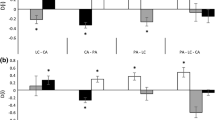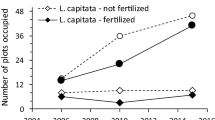Abstract
Invasive, non-native plant species often outcompete native species and reduce biodiversity. Invasive plants frequently begin growth before native plants, yet few studies have examined whether invasives win in competition partly by colonizing disturbed sites more quickly or by beginning growth earlier in the season than native plants (i.e. due to priority effects). We hypothesized that invasive plant species would benefit more from priority effects than would comparable native species and that earlier growth of invasive species would decrease plant biodiversity. To test this hypothesis, we grew three pairs of invasive and native plant species from three different functional groups/plant families (C3 grasses/Poaceae, non-leguminous forbs/Asteraceae, and legumes/Fabaceae). We seeded each of the species 3 weeks before seeding the other five species into large pots in a greenhouse. Consistent with our hypothesis, we found much stronger priority effects with invasive than native species. Each invasive species formed a near-monocultures when seeded first (97.5 % of total biomass, on average) whereas native species did not similarly dominate (29.8 % of total biomass, on average). Similarly, Simpson’s species diversity was 81 % higher when the initially sown species was native rather than invasive. The literature suggests that invasive species in the field often begin growth earlier in the spring than native species and that climate change may increasingly allow invasives to begin growth before native species, indicating invasive priority effects may become increasingly common.



Similar content being viewed by others
References
Abraham JK, Corbin JD, D’Antonio CM (2009) California native and exotic perennial grasses differ in their response to soil nitrogen, exotic annual grass density, and order of emergence. Plant Ecol 201:445–456
Casler MD, Undersander DJ, Fredericks C, Combs DK, Reed JD (1998) An on-farm test of perennial forage grass varieties under management intensive grazing. J Prod Agric 11:92–99
Clements DR, Cole DE, Darbyshire S, King J, McClay A (2004) The biology of Canadian weeds. 128. Leucanthemum vulgare Lam. Can J Plant Sci 84:343–363
Collinge SK, Ray C (2009) Transient patterns in the assembly of vernal pool plant communities. Ecology 90:3313–3323
Dawson W, Fischer M, van Kleunen M (2011) The maximum relative growth rate of common UK plant species is positively associated with their global invasiveness. Glob Ecol Biogeogr 20:299–306
Diez JM, Dickie I, Edwards G, Hulme PE, Sullivan JJ, Duncan RP (2010) Negative soil feedbacks accumulate over time for non-native plant species. Ecol Lett 13:803–809
Engelkes T, Morriën E, Verhoeven KJF, Bezemer TM, Biere A, Harvey JA, McIntyre LM, Tamis WLM, van der Putten WH (2008) Successful range-expanding plants experience less above-ground and below-ground enemy impact. Nature 456:946–948
Goldberg DE, Gurevitch J, Stewart-Oaten A (1999) Empirical approaches to quantifying interaction intensity: competition and facilitation along productivity gradients. Ecology 80:1118–1131
Grman E, Suding KN (2010) Within-year soil legacies contribute to strong priority effects of exotics on native California grassland communities. Restor Ecol 18:664–670
Gross KL, Pregitzer KS, Burton AJ (1995) Spatial variation in nitrogen availability in three successional plant communities. J Ecol 83:357–367
Grotkopp E, Erskine-Ogden J, Rejmánek M (2010) Assessing potential invasiveness of woody horticultural plant species using seedling growth rate traits. J Appl Ecol 47:1320–1328
Hedges LV, Gurevitch J, Curtis PS (1999) The meta-analysis of response ratios in experimental ecology. Ecology 80:1150–1156
Horvitz CC, Schemske DW (2002) Effects of plant size, leaf herbivory, local competition and fruit production on survival, growth and future reproduction of a neotropical herb. J Ecol 90:279–290
Körner C, Stöcklin J, Reuther-Thiébaud L, Pelaez-Riedl S (2008) Small differences in arrival time influence composition and productivity of plant communities. New Phytol 177:698–705
Littell RC, Stroup WW, Freund RJ (2002) SAS for linear models, 4th edn. SAS Institute Inc., Cary, NC
Mack RN, Lonsdale WM (2001) Humans as global plant dispersers: getting more than we bargained for. Bioscience 51:95–102
Mack RN, Simberloff D, Lonsdale WM, Evans H, Clout M, Bazzaz FA (2000) Biotic invasions: causes, epidemiology, global consequences, and control. Ecol Appl 10:689–710
Markle GM, Baron JJ, Schneider BA (1998) Food and feed crops of the United States, 2nd edn. Meister Publishing, Willoughby, Ohio
Martin PH, Canham CD, Marks PL (2009) Why forests appear resistant to exotic plant invasions: intentional introductions, stand dynamics, and the role of shade tolerance. Front Ecol Environ 7:142–149
McEwan RW, Birchfield MK, Schoergendorfer A, Arthur MA (2009) Leaf phenology and freeze tolerance of the invasive shrub Amur honeysuckle and potential native competitors. J Torrey Bot Soc 136:212–220
Mitchell CE, Power AG (2003) Release of invasive plants from fungal and viral pathogens. Nature 421:625–627
Parendes LA, Jones JA (2000) Role of light availability and dispersal in exotic plant invasion along roads and streams in the H.J. Andrews Experimental Forest, Oregon. Conserv Biol 14:64–75
Pyšek P, Richardson DM (2007) Traits associated with invasiveness in alien plants: where do we stand? Biol Invasions 193:97–125
Rabinowitz D, Rapp JK (1980) Seed rain in a North American tall grass prairie. J Appl Ecol 17:793–802
Rejmánek M, Richardson DM (1996) What attributes make some plant species more invasive? Ecology 77:1655–1661
Ross MA, Harper JL (1972) Occupation of biological space during seedling establishment. J Ecol 60:77–88
Seabloom EW, Harpole WS, Reichman OJ, Tilman D (2003) Invasion, competitive dominance, and resource use by exotic and native California grassland species. Proc Natl Acad Sci USA 100:13384–13389
Shulman MJ, Ogden JC, Ebersole JP, McFarland WN, Miller SL, Wolf NG (1983) Priority effects in the recruitment of juvenile coral reef fishes. Ecology 64:1508–1513
Smith B, Wilson JB (1996) A consumer’s guide to evenness indices. Oikos 76:70–82
Stevens JM, Fehmi JS (2011) Early establishment of a native grass reduces the competitive effect of a non-native grass. Restor Ecol 19:399–406
Suding KN, Gross KL, Houseman GR (2004) Alternative states and positive feedbacks in restoration ecology. Trends Ecol Evol 19:46–53
Swearingen JM (2008) Survey of invasive plants impacting national parks in the United States. National Park Service, Center for Urban Ecology. http://www.invasiveplantatlas.org/surveynps.pdf
Taylor NL (2008) A century of clover breeding developments in the United States. Crop Sci 48:1–13
Thompson JD, Norris WR, Lewis DQ (2009) The vascular flora of Ledges State Park (Boone County, Iowa) revisited: revelations and recommendations. Castanea 74:390–423
Trowbridge WB (2007) The role of stochasticity and priority effects in floodplain restoration. Ecol Appl 17:1312–1324
USDA, ARS (2011) Germplasm Resources Information Network. http://www.ars-grin.gov/
Wainwright CE, Wolkovich EM, Cleland EE (2012) Seasonal priority effects: implications for invasion and restoration in a semi-arid system. J Appl Ecol 49:234–241
Walther G-R, Post E, Convey P, Menzel A, Parmesan C, Beebee TJC, Fromentin J-M, Hoegh-Guldberg O, Bairlein F (2002) Ecological responses to recent climate change. Nature 416:389–395
Weber E (2003) Invasive plant species of the world: a reference guide to environmental weeds. CABI Publishing, Wallingford
Werner PA (1975) Predictions of fate from rosette size in teasel (Dipsacus fullonum L.). Oecologia 20:197–201
Willis CG, Ruhfel BR, Primack RB, Miller-Rushing AJ, Losos JB, Davis CC (2010) Favorable climate change response explains non-native species’ success in Thoreau’s woods. PLoS ONE 5:e8878
Wilsey BJ, Polley HW (2006) Aboveground productivity and root-shoot allocation differ between native and introduced grass species. Oecologia 150:300–309
Wilsey BJ, Teaschner TB, Daneshgar PP, Isbell FI, Polley HW (2009) Biodiversity maintenance mechanisms differ between native and novel exotic-dominated communities. Ecol Lett 12:432–442
Wilsey BJ, Daneshgar PP, Polley HW (2011) Biodiversity, phenology and temporal niche differences between native and novel exotic-dominated grasslands. Perspect Plant Ecol Evol Syst 13:265–276
Young TP, Petersen DA, Clary JJ (2005) The ecology of restoration: historical links, emerging issues and unexplored realms. Ecol Lett 8:662–673
Acknowledgments
We wish to especially thank Dr. Philip Dixon for statistical advice. We thank Forest Isbell, Steve Mahoney, Jen Richter, and Beatriz Spaulding for help in the greenhouse. Funding was provided by the National Science Foundation (DEB0639417).
Author information
Authors and Affiliations
Corresponding author
Electronic supplementary material
Below is the link to the electronic supplementary material.
Rights and permissions
About this article
Cite this article
Dickson, T.L., Hopwood, J.L. & Wilsey, B.J. Do priority effects benefit invasive plants more than native plants? An experiment with six grassland species. Biol Invasions 14, 2617–2624 (2012). https://doi.org/10.1007/s10530-012-0257-2
Received:
Accepted:
Published:
Issue Date:
DOI: https://doi.org/10.1007/s10530-012-0257-2




